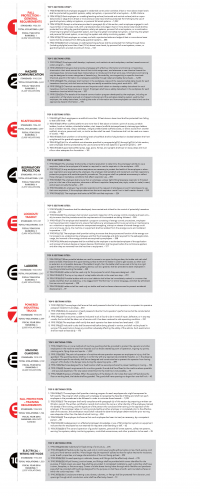Bryan Holland
Silver Member
OSHA’s Top 10
Each year OSHA publishes its list of most frequently cited violations. Employers and employees should be aware of these findings in order to assess their company’s health and safety programs to ensure they are meeting all requirements, not only for compliance purposes, but to maintain the safest workplace possible. The list also indicates that these standards receive a critical eye by compliance officers during inspections.
The list below includes the OSHA Standard and the specific OSHA Regulation (Title 29 of the Code of Federal Regulations). Section 1926 references the Construction Industry and Section 1910 applies to General Industry.
1. Scaffolding, general requirements (29 CFR 1926.451)
2. Fall protection, (29 CFR 1926.501)
3. Hazard communication standard, (29 CFR 1910.1200)
4. Ladders, (29 CFR 1926.1053)
5. Respiratory protection, (29 CFR 1910.134)
6. Control of hazardous energy (lockout/tagout), (29 CFR 1910.147)
7. Electrical, wiring methods, components and equipment, (29 CFR 1910.305)
8. Powered industrial trucks, (29 CFR 1910.178)
9. Electrical systems design, (29 CFR 1910.303)
10. Machines, general requirements, (29 CFR 1910.212)
The following are the standards for which OSHA assessed the highest penalties in fiscal year 2010 (October 1, 2009 through September 30, 2010):
1.Fall protection, construction (29 CFR 1926.501)
2.Electrical, general requirements, construction (29 CFR 1926.403)
3.Safety training and education, construction (29 CFR 1910.21)
4.Control of hazardous energy (lockout/tagout), general industry (29 CFR 1910.147)
5.Machines, general requirements, general industry (29 CFR 1910.212)
6.General duty clause (Section 5(a)(1) of the OSH Act) (this is where they get you on 70E)
7.Excavations, requirements for protective systems, construction (29 CFR 1926.652)
8.Lead, general industry (29 CFR 1910.1025)
9.Grain handling facilities (29 CFR 1910.272)
10.Ladders, construction (29 CFR 1926.1053)
Each year OSHA publishes its list of most frequently cited violations. Employers and employees should be aware of these findings in order to assess their company’s health and safety programs to ensure they are meeting all requirements, not only for compliance purposes, but to maintain the safest workplace possible. The list also indicates that these standards receive a critical eye by compliance officers during inspections.
The list below includes the OSHA Standard and the specific OSHA Regulation (Title 29 of the Code of Federal Regulations). Section 1926 references the Construction Industry and Section 1910 applies to General Industry.
1. Scaffolding, general requirements (29 CFR 1926.451)
2. Fall protection, (29 CFR 1926.501)
3. Hazard communication standard, (29 CFR 1910.1200)
4. Ladders, (29 CFR 1926.1053)
5. Respiratory protection, (29 CFR 1910.134)
6. Control of hazardous energy (lockout/tagout), (29 CFR 1910.147)
7. Electrical, wiring methods, components and equipment, (29 CFR 1910.305)
8. Powered industrial trucks, (29 CFR 1910.178)
9. Electrical systems design, (29 CFR 1910.303)
10. Machines, general requirements, (29 CFR 1910.212)
The following are the standards for which OSHA assessed the highest penalties in fiscal year 2010 (October 1, 2009 through September 30, 2010):
1.Fall protection, construction (29 CFR 1926.501)
2.Electrical, general requirements, construction (29 CFR 1926.403)
3.Safety training and education, construction (29 CFR 1910.21)
4.Control of hazardous energy (lockout/tagout), general industry (29 CFR 1910.147)
5.Machines, general requirements, general industry (29 CFR 1910.212)
6.General duty clause (Section 5(a)(1) of the OSH Act) (this is where they get you on 70E)
7.Excavations, requirements for protective systems, construction (29 CFR 1926.652)
8.Lead, general industry (29 CFR 1910.1025)
9.Grain handling facilities (29 CFR 1910.272)
10.Ladders, construction (29 CFR 1926.1053)


